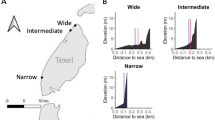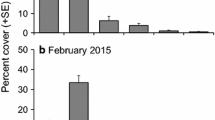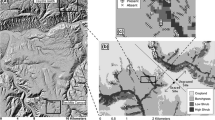Abstract
Different arrival order scenarios of native functional groups to a site may influence both resource use during development and final community structure. Arrival order may then indirectly influence community resistance to invasion. We present a mesocosm experiment of constructed coastal dune communities that monitored biotic and abiotic responses to different arrival orders of native functional groups. Constructed communities were compared with unplanted mesocosms. We then simulated a single invasion event by bitou (Chrysanthemoides monilifera ssp. rotundata), a dominant exotic shrub of coastal communities. We evaluated the hypothesis that plantings with simultaneous representation of grass, herb and shrub functional groups at the beginning of the experiment would more completely sequester resources and limit invasion than staggered plantings. Staggered plantings in turn would offer greater resource use and invasion resistance than unplanted mesocosms. Contrary to our expectations, there were few effects of arrival order on abiotic variables for the duration of the experiment and arrival order was unimportant in final community invasibility. All planted mesocosms supported significantly more invader germinants and significantly less invader abundance than unplanted mesocosms. Native functional group plantings may have a nurse effect during the invader germination and establishment phase and a competitive function during the invader juvenile and adult phase. Arrival order per se did not affect resource use and community invasibility in our mesocosm experiment. While grass, herb and shrub functional group plantings will not prevent invasion success in restored communities, they may limit final invader biomass.




Similar content being viewed by others
References
Allen SE (1989) Analysis of vegetation and other organic materials. In: Allen SE (ed) Chemical analysis of ecological materials. Blackwell, Oxford, pp 46–61
Allen JA (1997) Reforestation of bottomland hardwoods and the issue of woody species diversity. Restor Ecol 5:125–134
Auld TD, Bradstock RA (1996) Soil temperatures after the passage of a fire: do they influence the germination of buried seeds? Aust J Ecol 21:106–109
Baskin JM, Baskin CC (1989) Physiology of dormancy and germination in relation to seed bank ecology. In: Leck MA, Parker VT, Simpson RL (eds) Ecology of soil seed banks. Academic, San Diego, pp 53–66
Catovsky S, Bazzaz FA (2000) The role of resource interactions and seedling regeneration in maintaining a positive feedback in hemlock stands. J Ecol 88:100–112
Cavieres LA, Quiroz CL, Molina-Montenegro MA, Munoz AA, Pauchard A (2005) Nurse effect of the native cushion plant Azorella monantha on the invasive non-native Taraxacum officinale in the high-Andes of central Chile. Perspect Plant Ecol 7:217–226
Chadwell TB, Engelhardt KAM (2008) Effects of pre-existing submersed vegetation and propagule pressure on the invasion success of Hydrilla verticillata. J Appl Ecol 45:515–523
Corbin JD, D’Antonio CM (2004) Competition between native perennial and exotic annual grasses: implications for an historical invasion. Ecology 85:1273–1283
Day RW, Quinn GP (1989) Comparisons of treatments after an analysis of variance in ecology. Ecol Monogr 59:433–463
Dean TA, Hurd LE (1980) Development in an estuarine community: the influence of early colonists on later arrivals. Oecologia 46:295–301
Dickson TL, Foster BL (2011) Fertilizaton decreases plant biodiversity even when light is not limiting. Ecol Lett 14:380–388
Diggle AJ, Bell LC (1984) Movement of applied phosphorus following the mining and revegetation of mineral sands on Australia’s east coast. Aust J Soil Res 22:135–148
Dukes JS (2001) Biodiversity and invasibility in grassland microcosms. Oecologia 126:563–568
Eaton AD, Clesceri LS, Rice EW, Greenberg A, Franson MA (2005) Standard methods for the examination of water and wastewater. American Public Health Association, Washington
Emery SM, Gross KL (2007) Dominant species identity, not community evenness, regulates invasion in experimental grassland plant communities. Ecology 88:954–964
Ens E-J, French K, Bremner JB (2009) Evidence for allelopathy as a mechanism of community composition change by an invasive exotic shrub, Chrysanthemoides monilifera spp. rotundata. Plant Soil 316:125–137
Fargione J, Brown CS, Tilman D (2003) Community assembly and invasion: an experimental test of neutral versus niche processes. Proc Natl Acad Sci USA 100:8916–8920
Forge TA, Hogue EJ, Neilsen G, Neilsen D (2008) Organic mulches alter nematode communities, root growth and fluxes of phosphorus in the root zone of apple. Appl Soil Ecol 39:15–22
Grman E, Suding KN (2010) Within-year soil legacies contribute to strong priority effects of exotics on native California grassland communities. Restor Ecol 18:664–670
Harden GJ (1992) Flora of New South Wales, vol 3. University of New South Wales Press, Sydney
Harden GJ (1993) Flora of New South Wales, vol 4. University of New South Wales Press, Sydney
Harden GJ (2000) Flora of New South Wales, vol 1. University of New South Wales Press, Sydney
Harden GJ (2002) Flora of New South Wales, vol 2. University of New South Wales Press, Sydney
Jenkins DG, Buikema AL (1998) Do similar communities develop in similar sites? A test with zooplankton structure and function. Ecol Monogr 68:421–443
Kardol P, Souza L, Classen AT (2012) Resource availability mediates the importance of priority effects in plant community assembly and ecosystem function. Oikos doi:10.1111/j.1600-0706.2012.20546.x (in press)
Keith DA, Myerscough PJ (1993) Floristics and soil relations of upland swamp vegetation near Sydney. Aust J Ecol 18:325–344
Knops JMH, Tilman D, Haddad NM, Naeem S, Mitchell CE, Haarstad J, Ritchie ME, Howe KM, Reich PB, Siemann E, Groth J (1999) Effects of plant species richness on invasion dynamics, disease outbreaks, insect abundances and diversity. Ecol Lett 2:286–293
Ladd B, Facelli JM (2008) Priority effects produced by plant litter result in non-additive competitive effects. Oecologia 157:687–696
Lenz TI, Facelli JM (2003) Shade facilitates an invasive stem succulent in a chenopod shrubland in South Australia. Aust Ecol 28:480–490
Lindsay EA, French K (2005) Litterfall and nitrogen cycling following invasion by Chrysanthemoides monilifera ssp. rotundata in coastal Australia. J Appl Ecol 42:556–566
Lulow ME (2004) Restoration in California’s inland grasslands: the role of priority effects and management strategies in establishing native communities and the ability of native grasses to resist invasion by non-native grasses. PhD dissertation, University of California, Davis
Mahmoodzadeh H (2010) Allelopathic plants 23. Cynodon dactylon (L.) Pers. Allelopath J 25:227–238
Maron JL, Connors PG (1996) A native nitrogen-fixing shrub facilitates weed invasion. Oecologia 105:302–312
Mason TJ, French K (2008) Impacts of a woody invader vary in different vegetation communities. Divers Distrib 14:829–838
Mason TJ, French K, Russell K (2012) Are competitive effects of native species on an invader mediated by water availability? J Veg Sci 23:657–666
Maze KM, Whalley RDB (1992) Effects of salt spray and sand burial on Spinifex sericeus R.Br. Aust J Ecol 17:9–19
McConnaughay KDM, Bazzaz FA (1991) Is physical space a soil resource? Ecology 72:94–103
Okin GS, Mladenov N, Wang L, Cassel D, Caylor KK, Ringrose S, Macko SA (2008) Spatial patterns of soil nutrients in two southern African savannas. J Geophys Res 113:GO2011
Perry LG, Neuhauser C, Galatowitsch SM (2003) Founder control and coexistence in a simple model of asymmetric competition for light. J Theor Biol 222:425–436
Prieur-Richard A-H, Lavorel S, Grigulis K, Dos Santos A (2000) Plant community diversity and invasibility by exotics: invasion of Mediterranean old fields by Conyza bonariensis and Conyza canadansis. Ecol Lett 3:412–422
Robinson JV, Dickerson JEJ (1987) Does invasion sequence affect community structure? Ecology 68:587–595
Scheiner SM (1993) MANOVA: multiple response variables and multispecies interactions. In: Scheiner SM, Gurevitch J (eds) Design and analysis of ecological experiments. Chapman and Hall, New York, pp 94–112
Schlesinger WH, Raikes JA, Hartley AE, Cross AF (1996) On the spatial pattern of soil nutrients in desert ecosystems. Ecology 77:364–374
Simpson SL, Pryor ID, Mewburn BR, Batley GE, Jolley DF (2002) Considerations for capping metal-contaminated sediments in dynamic estuarine environments. Environ Sci Technol 36:3772–3778
Symstad AJ, Tilman D (2001) Diversity loss, recruitment limitation, and ecosystem functioning: lessons learned from a removal experiment. Oikos 92:424–435
Tackett NW, Craft CB (2010) Ecosystem development on a coastal barrier island dune chronosequence. J Coast Res 26:736–742
Teutsch-Hausmann N, Hawkes CV (2010) Order of plant host establishment alters the composition of arbuscular mycorrhizal communities. Ecology 91:2333–2343
Walker J, Hopkins MS (1990) Vegetation. In: McDonald RC, Isbell RF, Speight JG, Walker J, Hopkins MS (eds) Australian soil and land survey field handbook. Inkata, Melbourne
Walker LR, Landau FH, Velázquez E, Shiels AB, Sparrow AD (2010) Early successional woody plants facilitate and ferns inhibit forest development on Puerto Rican landslides. J Ecol 98:625–635
Wardle DA, Nilsson M-C, Gallet C, Zackrisson O (1998) An ecosystem-level perspective of allelopathy. Biol Rev 73:305–319
Welch BL (1951) On the comparison of several mean values: an alternative approach. Biometrika 38:330–336
Wiegand K, Ward D, Saltz D (2005) Multi-scale patterns and bush encroachment in an arid savanna with a shallow soil layer. J Veg Sci 16:311–320
Wilsey BJ (2010) Productivity and subordinate species response to dominant grass species and seed source during restoration. Restor Ecol 18:628–637
Young TP, Petersen DA, Clary JJ (2005) The ecology of restoration: historical links, emerging issues and unexplored realms. Ecol Lett 8:662–673
Acknowledgments
We thank Natalie Sullivan, Eva Watts, James Wallace, Brendon Neilly, Ben Jenner, Jamin Hudson, Emilie-Jane Ens, Corrine De Mestre, Russell McWilliam, Meron Oxley and Ben Gooden for assistance with set up, monitoring and processing the mesocosm experiment, Mohammad Almoiqli for assistance with ICP-AES analyses, Marijka Batterham for statistical advice and Brian Jones and Brent Peterson for assistance with soil coring. The manuscript was greatly improved by comments from two anonymous reviewers and the editorial team at Oecologia. Financial support for the research was provided by Land and Water Australia and NSW Environmental Trust. The experiments comply with current Australian laws.
Author information
Authors and Affiliations
Corresponding author
Additional information
Communicated by Bryan Foster.
Electronic supplementary material
Below is the link to the electronic supplementary material.e
Rights and permissions
About this article
Cite this article
Mason, T.J., French, K. & Jolley, D. Arrival order among native plant functional groups does not affect invasibility of constructed dune communities. Oecologia 173, 557–568 (2013). https://doi.org/10.1007/s00442-013-2628-5
Received:
Accepted:
Published:
Issue Date:
DOI: https://doi.org/10.1007/s00442-013-2628-5




